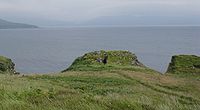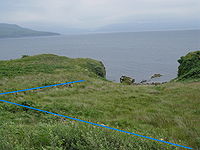
Dun Ringill
Encyclopedia

Skye
Skye or the Isle of Skye is the largest and most northerly island in the Inner Hebrides of Scotland. The island's peninsulas radiate out from a mountainous centre dominated by the Cuillin hills...
, Scotland
Scotland
Scotland is a country that is part of the United Kingdom. Occupying the northern third of the island of Great Britain, it shares a border with England to the south and is bounded by the North Sea to the east, the Atlantic Ocean to the north and west, and the North Channel and Irish Sea to the...
. Further fortified in the Middle Ages, tradition holds that it was for several centuries the seat of Clan MacKinnon
Clan MacKinnon
Clan Mackinnon or Clan Fingon is a Highland Scottish clan associated with the islands of Mull and Skye, in the Inner Hebrides.Popular tradition gives the clan a Dalriadic Gaelic origin. The 19th century historian W. F. Skene named the clan as one of the seven clans of Siol Alpin - who according to...
. It is located on the peninsula of Strathaird
Strathaird
Strathaird is a peninsula on the island of Skye, Scotland, situated between Loch Slapin and Loch Scavaig on the south coast.Skye's shape defies description and W. H. Murray said that "Skye is sixty miles long, but what might be its breadth is beyond the ingenuity of man to state". Strathaird is...
east of Kirkibost on the west shore of Loch Slapin.
History
The original structure of Dun Ringill is consistent with an Iron Age BrochBroch
A broch is an Iron Age drystone hollow-walled structure of a type found only in Scotland. Brochs include some of the most sophisticated examples of drystone architecture ever created, and belong to the classification "complex Atlantic Roundhouse" devised by Scottish archaeologists in the 1980s....
dating to approximately the first years of the common era
Common Era
Common Era ,abbreviated as CE, is an alternative designation for the calendar era originally introduced by Dionysius Exiguus in the 6th century, traditionally identified with Anno Domini .Dates before the year 1 CE are indicated by the usage of BCE, short for Before the Common Era Common Era...
. The main and subordinate structures have been occupied and modified throughout its history until the 19th century. Tradition relates that the structure was occupied by the MacKinnons as their clan seat well before the 16th century. It is mentioned in historical texts in the 16th century after which the MacKinnon's moved their seat to Dunakin.
Description

Broch
A broch is an Iron Age drystone hollow-walled structure of a type found only in Scotland. Brochs include some of the most sophisticated examples of drystone architecture ever created, and belong to the classification "complex Atlantic Roundhouse" devised by Scottish archaeologists in the 1980s....
, a form of complex Atlantic roundhouse
Atlantic roundhouse
In archaeology, an Atlantic roundhouse is an Iron Age stone building found in the northern and western parts of mainland Scotland, the Northern Isles and the Hebrides.-Types of structure:...
.

To the north and west is a hilly coastal plain. Loch Slapin lies to the east and south of the structure. On either side of the structure are earth and stone ramps that descend down to the ocean. These ramps likely allowed easy access to the water and shipping. Since roads in this part of Skye did not exist until recent times, sea travel was the predominant mode of transportation.
Dun Ringill in popular culture
The musical group Jethro TullJethro Tull (band)
Jethro Tull are a British rock group formed in 1967. Their music is characterised by the vocals, acoustic guitar, and flute playing of Ian Anderson, who has led the band since its founding, and the guitar work of Martin Barre, who has been with the band since 1969.Initially playing blues rock with...
performed a song entitled Dun Ringill on their 1979 Stormwatch
Stormwatch (album)
Stormwatch is the twelfth studio album by the rock group Jethro Tull. It is considered the last in the trilogy of folk-rock albums by Jethro Tull...
album. The lyrics call for a meeting down by Dun Ringill during the early hours of a stormy night, when "we'll watch the old gods play". The song was written by Tull leader Ian Anderson
Ian Anderson (musician)
Ian Scott Anderson, MBE is a Scottish singer, songwriter and multi-instrumentalist, best known for his work as the leader and flautist of British rock band Jethro Tull.-Early life:...
, who lived at Kilmarie House, within walking distance of Dun Ringill, at the time.

